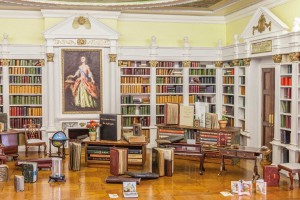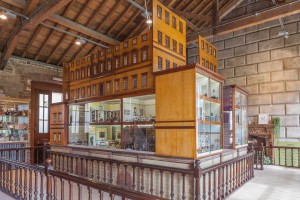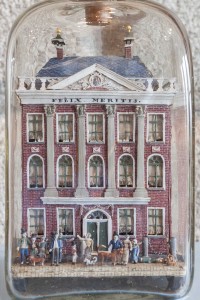Tara’s Palace and Museum of Childhood
Published in Issue 6 (November/December 2014), Reviews, Volume 22Powerscourt House, Enniskerry, Co. Wicklow
www.taraspalace.ie
By Denis Casey

The library is decorated in Regency style, with a portrait and ceiling painted by Thomas Ryan (a past president of the RHA), and is stocked with a collection of over 100 miniature books.
Formerly situated at Malahide Castle and now located in three of the upper rooms of Powerscourt House, Enniskerry, Tara’s Palace and Museum of Childhood is a small attraction dedicated to both children and adults that houses a 25-room miniature doll’s palace and a collection of toys of yesteryear.
On entering the reception/shop, visitors are confronted by a dapper-looking teddy bear driving a 1920s-style pedal-car Bugatti and a few other curiosities, such as a toy Noah’s Ark (with menagerie) used for Sunday School biblical teaching in the nineteenth century. Passing through the reception area, one immediately encounters the museum’s impressive centrepiece: Tara’s Palace, a 9m-wide period doll’s palace. This one-twelfth-scale satinwood, mahogany and marble masterpiece is Ireland’s largest period doll’s house. It was the brainchild of the late Ronnie McDonnell, former president of the Irish Antique Dealers Association. Upon failing in a bid to retain Titania’s Palace in Ireland—a similar structure made for Sir Nevile Wilkinson (owner of Mount Merrion House) in 1907—McDonnell commissioned a new one along the same dimensions and gave it a more Celtic-sounding name. Although it is of relatively modern construction (c. 1980), it contains both antique and specially commissioned items of exquisite craftsmanship. Peering into it, one is reminded of Gerald of Wales’s comment on the decoration of medieval Irish illuminated manuscripts: ‘you will see nothing subtle where everything is subtle’.
Each of the rooms in Tara’s Palace is laid out according to a theme or as it might have appeared in the great eighteenth-century houses upon which the palace is based (Carton House, Castletown House and Leinster House). Particularly fascinating are some of the items in the Ivory Room, such as the incredibly intricate cabinets made in Goa, India, and the delicate cat and mice that were whittled by French prisoners of the Napoleonic wars from the bones of their food rations. Likewise, items of miniature blue and white seventeenth/
eighteenth-century Chinese porcelain from the K’ang Hsi period are found scattered throughout the palace. Undoubtedly one of the most attractive rooms is the library. It is decorated in Regency style, with a portrait and ceiling painted by Thomas Ryan (past president of the Royal Hibernian Academy), and is stocked with a collection of over 100 miniature books. Many are from the Georgian period, though modern books may be found, including an ironically thumbnail-sized pop-up Gulliver’s Travels. Visitors are given an information sheet on the contents of the palace’s rooms, and an illustrated booklet is also available for purchase in the shop. In addition, the volunteer staff provide a brief introduction to each visitor and seem happy to discuss the collections in greater detail.
The craftsmanship of the items in Tara’s Palace, and the interest shown by other visitors pressing their noses and cameras against its perspex covers, makes one almost overlook some of the interesting items that line the cases along three of the room’s four walls. There one finds a series of collections, including a fine assemblage of miniature furniture pieces, cabinets of post-war Dinky cars (some of which are probably now worth more than the originals) and late nineteenth/early twentieth-century model circus and gypsy carriages.

The museum’s impressive centrepiece: Tara’s Palace, a 9m-wide period doll’s palace. This one-twelfth-scale satinwood, mahogany and marble masterpiece is Ireland’s largest period doll’s house.
Moving through the archway into the adjoining room, visitors are presented with a much more eclectic assortment of items. These range from a c. 1700 doll’s house named ‘Portobello’, one of the earliest known doll’s houses in Britain or Ireland (formerly in the collection of Vivien Greene, widow of the novelist Graham Greene), to an unusual 2ft-high Countess Constance Markievicz doll, armed and in uniform. In contrast to the previous room, this one has a distinct bric-à-brac or curiosity shop (rather than museum) feel, and some of the older exhibits (such as a nineteenth-century rocking-horse) are in need of conservation. Thankfully, many of the larger items in this room are well labelled.
As befits an exhibition dedicated to childhood, particular attention is paid to younger visitors. They are provided with a scavenger-hunt-style quiz that encourages them to engage with the exhibits and are offered small treats upon completion. Furthermore, a children’s activity room (connected to the two exhibition rooms) offers parents the welcome opportunity to browse the collections at leisure while their children remain occupied.
Tours for groups can be booked in advance and Tara’s Palace also takes bookings for children’s birthday parties, which are offered special rates. The museum is staffed by volunteers and—in keeping with the spirit of the exhibition—all profits are donated to Irish children’s charities, which are listed on a display board and on the Tara’s Palace website.
Although not quite a museum in the traditional sense, Tara’s Palace has a lot to offer visitors interested in antique toys, while the craftsmanship of the antique and modern miniatures in its centrepiece is a joy to behold. Overall, it is well worth a leisurely 45-minute visit and should appeal to young and old alike.
Denis Casey lectures part-time at the Department of Early Irish at NUI Maynooth.

















